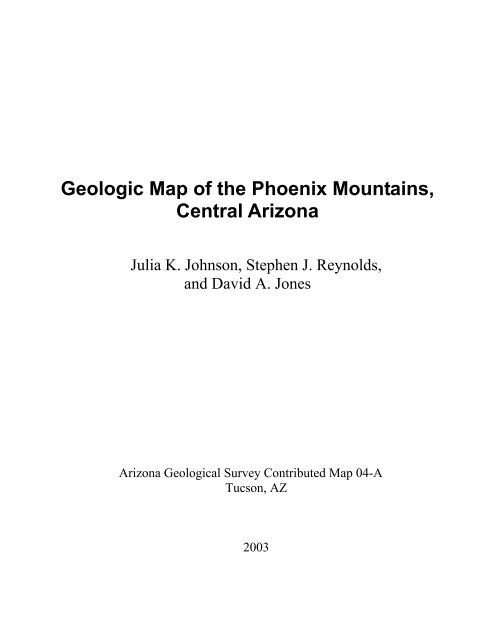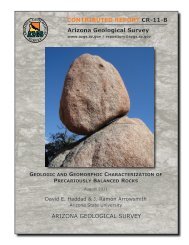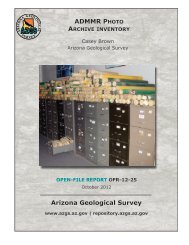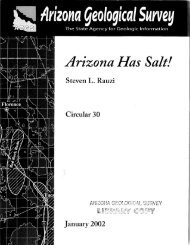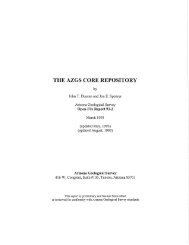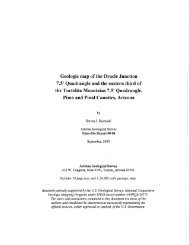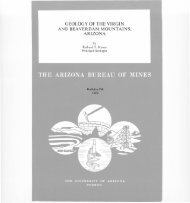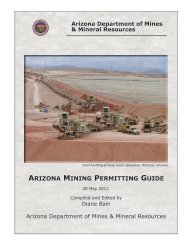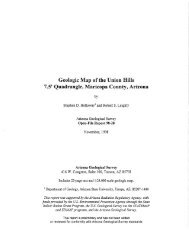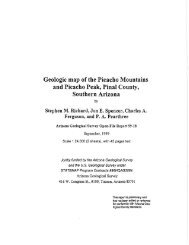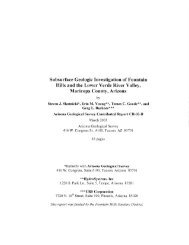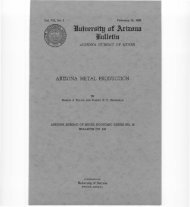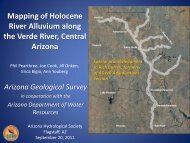Geologic Map of the Phoenix Mountains, Central Arizona - AZGS ...
Geologic Map of the Phoenix Mountains, Central Arizona - AZGS ...
Geologic Map of the Phoenix Mountains, Central Arizona - AZGS ...
Create successful ePaper yourself
Turn your PDF publications into a flip-book with our unique Google optimized e-Paper software.
<strong>Geologic</strong> <strong>Map</strong> <strong>of</strong> <strong>the</strong> <strong>Phoenix</strong> <strong>Mountains</strong>,<br />
<strong>Central</strong> <strong>Arizona</strong><br />
Julia K. Johnson, Stephen J. Reynolds,<br />
and David A. Jones<br />
<strong>Arizona</strong> <strong>Geologic</strong>al Survey Contributed <strong>Map</strong> 04-A<br />
Tucson, AZ<br />
2003
Introduction<br />
The <strong>Phoenix</strong> <strong>Mountains</strong>, located within <strong>the</strong> <strong>Phoenix</strong> metropolitan area <strong>of</strong> central <strong>Arizona</strong>,<br />
are a northwest-trending, uplifted fault block that extends for about 13 km (8 miles) from Moon<br />
Hill in <strong>the</strong> northwest to Camelback Mountain in <strong>the</strong> sou<strong>the</strong>ast (Fig. 1). The area includes a main<br />
range, with 420 m (1,378 ft) <strong>of</strong> local relief, as well as several isolated peaks. The geologic<br />
mapping for this study covers <strong>the</strong> main part <strong>of</strong> <strong>the</strong> range, including (from northwest to sou<strong>the</strong>ast)<br />
Moon Hill, Shaw Butte, North Mountain, Stoney Mountain, Dreamy Draw, Squaw Peak, and <strong>the</strong><br />
informally named Quartzite Ridge.<br />
The main goals <strong>of</strong> this study were to document <strong>the</strong> bedrock geology, reconstruct <strong>the</strong><br />
geologic history, and produce a 1:24,000 geologic map <strong>of</strong> <strong>the</strong> range. The area contains a<br />
remarkable stratigraphic sequence that records <strong>the</strong> formation <strong>of</strong> continental crust in <strong>the</strong> region as<br />
it evolved from an oceanic setting to a more continental setting. The rocks have been cleaved<br />
and steeply tilted, providing a well-exposed traverse through this exceptional sequence. The<br />
range also contains spectacular Proterozoic (Precambrian) structures, which document <strong>the</strong><br />
extreme deformation that affected <strong>the</strong> crust soon after it had formed.<br />
Shaw<br />
Butte<br />
Moon<br />
Hill<br />
Lookout<br />
Mtn.<br />
Thunderbird<br />
Hills<br />
North<br />
Mtn.<br />
Stoney<br />
Mtn.<br />
Shadow<br />
Mtn.<br />
Peak<br />
Dreamy Draw Squaw<br />
1<br />
Quartzite<br />
Ridge<br />
Mummy<br />
Mtn.<br />
Camelback<br />
Mtn.<br />
Figure 1. Three-dimensional perspective <strong>of</strong> <strong>the</strong> <strong>Phoenix</strong> <strong>Mountains</strong>, looking north.<br />
Prior to this study, <strong>the</strong>re was no comprehensive view <strong>of</strong> <strong>the</strong> geology <strong>of</strong> <strong>the</strong> range. Early<br />
studies in <strong>the</strong> <strong>Phoenix</strong> <strong>Mountains</strong> were mainly concerned with water resources and <strong>the</strong> scattered<br />
mines and prospects (Lee, 1905; Schrader, 1918; and o<strong>the</strong>r references cited in Johnson, 2000).<br />
Wilson et al. (1957) produced a 1:375,000 geologic map <strong>of</strong> Maricopa County. Several master’s<br />
<strong>the</strong>ses focused on aspects <strong>of</strong> <strong>the</strong> range (Aylor, 1973; Shank, 1973; Cordy, 1978; Thorpe, 1980;
Thorpe and Burt, 1978, 1980). The Proterozoic geology <strong>of</strong> <strong>the</strong> <strong>Phoenix</strong> <strong>Mountains</strong> has been<br />
studied in reconnaissance as part <strong>of</strong> several regional works (Anderson, 1989a, b; Karlstrom et<br />
al., 1990; Reynolds and DeWitt, 1991; Reynolds and Grubensky, 1993).<br />
<strong>Map</strong>ping for <strong>the</strong> present study was carried out in 1995-1996 (D.A. Jones and S.J. Reynolds)<br />
and 1999-2002 (J.K. Johnson and S.J. Reynolds), utilizing 1:12,000-scale enlargements <strong>of</strong> <strong>the</strong><br />
Paradise Valley and Sunnyslope U.S. <strong>Geologic</strong>al Survey 7.5-minute quadrangles as a<br />
topographic base. <strong>Geologic</strong> mapping in <strong>the</strong> Squaw Peak area is from D. Jones (1996), whose<br />
mapping covered <strong>the</strong> area between <strong>the</strong> Squaw Peak Parkway and <strong>the</strong> first large ridge <strong>of</strong> quartzite<br />
east <strong>of</strong> Squaw Peak. The rest <strong>of</strong> <strong>the</strong> range was mapped by J. Johnson and S. Reynolds. The<br />
geologic map was compiled by Johnson and Reynolds, and an early version was included in <strong>the</strong><br />
<strong>the</strong>sis by Johnson (2000).<br />
<strong>Geologic</strong> Overview<br />
The geology <strong>of</strong> <strong>the</strong> <strong>Phoenix</strong> <strong>Mountains</strong> is dominated by Proterozoic low-grade metamorphic<br />
rocks that display a nor<strong>the</strong>ast-striking, steeply sou<strong>the</strong>ast-dipping cleavage. A 12-km-thick<br />
sequence <strong>of</strong> Precambrian metamorphic rocks is exposed in <strong>the</strong> <strong>Phoenix</strong> <strong>Mountains</strong>, but internal<br />
strain and duplication <strong>of</strong> beds by faulting and folding have obscured <strong>the</strong> original thickness; most<br />
units have been thinned by <strong>the</strong> deformation. Two distinct Proterozoic sequences are preserved,<br />
separated by <strong>the</strong> north-nor<strong>the</strong>ast-trending Squaw Peak structure in <strong>the</strong> center <strong>of</strong> <strong>the</strong> range.<br />
West <strong>of</strong> <strong>the</strong> structure is a 7-km-thick, nonrepeated sequence <strong>of</strong> greenstones, felsic volcanics,<br />
ferruginous quartzite, and metasedimentary rocks that become younger toward <strong>the</strong> sou<strong>the</strong>ast.<br />
The oldest unit in this sequence is <strong>the</strong> North Mountain Greenstone exposed near Shaw Butte and<br />
North Mountain. The greenstone is intruded to <strong>the</strong> west by <strong>the</strong> Proterozoic Shaw Butte<br />
Granodiorite. To <strong>the</strong> east is a north-trending belt <strong>of</strong> felsic volcanic and volcaniclastic rocks that<br />
straddle 7 th Street. Fur<strong>the</strong>r east are more greenstones, a sequence <strong>of</strong> interbedded phyllite and<br />
rhyolitic tuff along Cave Creek Road, and a cover <strong>of</strong> basalt and Tertiary conglomerate. Stoney<br />
Mountain to <strong>the</strong> sou<strong>the</strong>ast exposes a thick package <strong>of</strong> Stoney Mountain Greenstone, which<br />
contains interbeds <strong>of</strong> ferruginous quartzite and graywacke. Upsection to <strong>the</strong> sou<strong>the</strong>ast, near<br />
Dreamy Draw, <strong>the</strong> greenstone is overlain by sou<strong>the</strong>ast-dipping, metasedimentary phyllite,<br />
volcaniclastic rocks, and local quartzite. The progression toward more mature rocks continues<br />
sou<strong>the</strong>ast <strong>of</strong> Dreamy Draw, where <strong>the</strong> phyllite is overlain by conglomeratic quartzite and<br />
quartzite. In this area, <strong>the</strong> sequence is folded around <strong>the</strong> isoclinal, steeply plunging Dreamy<br />
Draw syncline; <strong>the</strong> units reappear, but are overturned, on <strong>the</strong> eastern limb <strong>of</strong> <strong>the</strong> syncline. The<br />
eastern limb is truncated by <strong>the</strong> north-nor<strong>the</strong>ast-trending Squaw Peak structure, which is<br />
somewhat enigmatic because it is a fault near Squaw Peak (Jones, 1996), but elsewhere is a shear<br />
zone or a foliated contact juxtaposing dissimilar rock types or sequences with opposite facing<br />
directions.<br />
East <strong>of</strong> <strong>the</strong> Squaw Peak structure are several kilometers <strong>of</strong> quartzite, phyllite, and rhyolite,<br />
repeated by several large folds. The oldest parts <strong>of</strong> this sequence are in <strong>the</strong> eastern part <strong>of</strong> <strong>the</strong><br />
range and consist <strong>of</strong> interbedded quartzite, phyllite, volcaniclastic rocks, and metarhyolite.<br />
Facing directions in <strong>the</strong> quartzites are to <strong>the</strong> sou<strong>the</strong>ast in exposures east <strong>of</strong> 32 nd Street and to <strong>the</strong><br />
northwest from 32 nd Street west to Squaw Peak. We conclude that a large, isoclinal fold (32 nd<br />
Street fold) separates <strong>the</strong> outward-facing sections and repeats several thin metarhyolites within<br />
<strong>the</strong> phyllites. Ano<strong>the</strong>r large isoclinal fold, <strong>the</strong> steeply plunging Squaw Peak syncline, causes<br />
altered metarhyolite at Squaw Peak to wrap around a core <strong>of</strong> younger quartzite (Jones, 1996).<br />
The west limb <strong>of</strong> this syncline is truncated by <strong>the</strong> Squaw Peak structure. Some boundaries<br />
2
etween quartzite and phyllite just east <strong>of</strong> Squaw Peak are probably in part shear zones because<br />
<strong>the</strong>y truncate folded bedding in <strong>the</strong> quartzites.<br />
The Proterozoic rocks nearly everywhere display a well-developed slaty cleavage or<br />
schistosity that generally strikes nor<strong>the</strong>ast and dips steeply or moderately to <strong>the</strong> sou<strong>the</strong>ast. This<br />
planar fabric is defined by <strong>the</strong> preferred orientation <strong>of</strong> mica grains, segregated felsic and mafic<br />
minerals, and flattened crystals and clasts. It is best developed in fine-grained metavolcanic and<br />
metasedimentary rocks, but is less developed in quartzites and coarse greenstones. A sou<strong>the</strong>astplunging,<br />
down-dip lineation is defined by <strong>the</strong> long axes <strong>of</strong> stretched clasts and phenocrysts.<br />
Associated with <strong>the</strong> cleavage are countless small folds and several large, steeply plunging<br />
isoclinal folds. The Shaw Butte Granodiorite is cut by ductile shear zones that are parallel to<br />
cleavage in <strong>the</strong> adjacent metavolcanic rocks. Deformation in <strong>the</strong> range was accompanied by<br />
low-grade, greenschist-facies metamorphism. Small post-metamorphic faults, most <strong>of</strong> which<br />
trend east-west, typically <strong>of</strong>fset units tens <strong>of</strong> meters.<br />
Primary bedding in <strong>the</strong> Proterozoic rocks is expressed by lithologic contacts, compositional<br />
variations, dark mineral laminations, graded bedding, and cross-bed sets. Facing directions<br />
shown on <strong>the</strong> map are largely based on cross beds and rare graded bedding and scour features.<br />
Bedding is generally parallel to <strong>the</strong> nor<strong>the</strong>ast-striking cleavage, except in <strong>the</strong> hinges <strong>of</strong> folds<br />
where bedding cuts across cleavage at a high angle.<br />
Tertiary rocks in <strong>the</strong> <strong>Phoenix</strong> <strong>Mountains</strong> include conglomerates and gently tilted basalt<br />
flows and basalt breccias exposed in <strong>the</strong> nor<strong>the</strong>rn and western parts <strong>of</strong> <strong>the</strong> range. These overlie<br />
<strong>the</strong> Proterozoic rocks along an angular unconformity. Basin-fill sediments that postdate some or<br />
perhaps all <strong>of</strong> <strong>the</strong> basalts form low, rounded hills along <strong>the</strong> north flank <strong>of</strong> <strong>the</strong> range. The<br />
youngest map units are relatively flat-lying Quaternary surficial deposits that surround <strong>the</strong> range<br />
and were deposited unconformably over all rock types in <strong>the</strong> area.<br />
Area Summaries<br />
Introduction: The mapped area can be divided into 10 subareas, based on physiography<br />
and geology. Each area is described briefly below, more or less from <strong>the</strong> northwest to <strong>the</strong><br />
sou<strong>the</strong>ast (Figure 1).<br />
Moon Hill: This small hill in <strong>the</strong> northwestern part <strong>of</strong> <strong>the</strong> range is composed entirely <strong>of</strong><br />
flat-lying to gently nor<strong>the</strong>ast-tilted Tertiary basalt flows, flanked by talus.<br />
Lookout Mountain: Lookout Mountain is <strong>the</strong> nor<strong>the</strong>rnmost peak in <strong>the</strong> range. It consists<br />
<strong>of</strong> an older Tertiary basalt flow, successively overlain by Tertiary sediments and a younger<br />
Tertiary basalt flow and basalt breccia. The lower basalt has been estimated to be approximately<br />
20 Ma (Leighty, 1997).<br />
Shaw Butte: Shaw Butte, located in <strong>the</strong> northwestern end <strong>of</strong> <strong>the</strong> range, consists <strong>of</strong><br />
Proterozoic granodiorite and tonalite (Shaw Butte Granodiorite) overlain by two basalt flows<br />
similar to those at Moon Hill. An older basalt has been dated at approximately 20 Ma, whereas<br />
<strong>the</strong> younger basalt caps <strong>the</strong> butte and has been estimated to be 13 Ma to 16 Ma (Leighty, 1997).<br />
The east side <strong>of</strong> <strong>the</strong> Shaw Butte Granodiorite intrudes Proterozoic greenstone and has a<br />
complex suite <strong>of</strong> fine-grained to porphyritic granodiorite, interpreted to be a chilled border phase<br />
<strong>of</strong> <strong>the</strong> main pluton. If <strong>the</strong> pluton has been tilted along with <strong>the</strong> rest <strong>of</strong> <strong>the</strong> Proterozoic rocks in <strong>the</strong><br />
range, <strong>the</strong>n <strong>the</strong> fine-grained phase could represent <strong>the</strong> original top <strong>of</strong> <strong>the</strong> pluton. The<br />
granodiorite contains numerous shear zones and is locally well foliated.<br />
North Mountain and 7th Street Area: Greenstone and felsic metavolcanics dominate<br />
North Mountain and <strong>the</strong> 7th Street area. The greenstones are intermediate to mafic in<br />
3
composition and have both a finely crystalline and coarsely crystalline component, probably<br />
representing extrusive and intrusive protoliths. The coarser phase <strong>of</strong> <strong>the</strong> greenstone is to <strong>the</strong><br />
west, in <strong>the</strong> lower, perhaps <strong>the</strong> originally deeper, parts <strong>of</strong> <strong>the</strong> sequence. At North Mountain, <strong>the</strong><br />
cleavage bends from vertical at <strong>the</strong> base <strong>of</strong> <strong>the</strong> hill to moderately west-dipping at <strong>the</strong> crest. A belt<br />
<strong>of</strong> metamorphosed rhyolite tuff and felsic volcaniclastic rocks trends northward along both sides<br />
<strong>of</strong> 7th Street.<br />
Thunderbird Hills: The low-relief hills near Thunderbird Road and 7th Street are<br />
composed <strong>of</strong> Tertiary sediments that unconformably overlie greenstone on <strong>the</strong> west and Tertiary<br />
basalt on <strong>the</strong> east. The sediments are weakly consolidated and contain clasts <strong>of</strong> basalt,<br />
crystalline rock, greenstone, fine-grained quartzite, ferruginous quartzite, and metarhyolite.<br />
Sou<strong>the</strong>ast <strong>of</strong> <strong>the</strong>se Tertiary sediments is ferruginous quartzite overlain by a sequence <strong>of</strong> very<br />
fine-grained metasiltstone and metarhyolite.<br />
Shadow Mountain: Rocks at Shadow Mountain cannot be correlated with rock units in <strong>the</strong><br />
rest <strong>of</strong> <strong>the</strong> range. Most <strong>of</strong> Shadow Mountain is a sequence <strong>of</strong> metamorphosed volcanic,<br />
volcaniclastic, and sedimentary rocks interbedded with metamorphosed flow-banded rhyolite and<br />
tuff. Exposed at <strong>the</strong> tip <strong>of</strong> <strong>the</strong> northwest ridge is an unusual massive quartzite containing quartzkyanite-andalusite<br />
rock.<br />
Stoney Mountain: Stoney Mountain is mostly composed <strong>of</strong> an intermediate-composition<br />
greenstone intermixed with abundant ferruginous quartzite, graywacke, phyllite, and a few<br />
tuffaceous units, all <strong>of</strong> which contain carbonate in varying amounts. The greenstone varies from<br />
fine to medium grained, with <strong>the</strong> finer parts originally being intermediate to mafic volcanics and<br />
<strong>the</strong> coarser parts probably being gabbroic to dioritic intrusions. The ferruginous quartzite has<br />
abundant chert clasts and numerous small, but well-developed, steeply plunging folds, especially<br />
in <strong>the</strong> sou<strong>the</strong>rn Stoney Mountain area.<br />
Dreamy Draw Area: The Dreamy Draw area straddles <strong>the</strong> Squaw Peak Parkway. It is<br />
composed mostly <strong>of</strong> gray and tan phyllite, but also includes a lens <strong>of</strong> orthoquartzite. This area<br />
represents <strong>the</strong> transition from a more oceanic setting down section to a more continental setting<br />
up section, as greenstones and ferruginous quartzite pass upward into continental quartzite. The<br />
section is repeated by <strong>the</strong> steep-plunging Dreamy Draw syncline.<br />
Squaw Peak: Squaw Peak is <strong>the</strong> highest peak in <strong>the</strong> range, with an elevation <strong>of</strong> 782 m<br />
(2608 ft.). West <strong>of</strong> Squaw Peak is a large, nor<strong>the</strong>ast-striking reverse fault or shear zone, <strong>the</strong><br />
Squaw Peak structure, across which units cannot be correlated. To <strong>the</strong> north and northwest are<br />
greenstone, greenschist, phyllite, and conglomeratic quartzite, whereas east <strong>of</strong> <strong>the</strong> structure are<br />
more continental units, including cross-bedded quartzite, metarhyolite, and metamorphosed tuff<br />
breccia. The large, nor<strong>the</strong>ast-plunging Squaw Peak syncline folds <strong>the</strong> quartzite and metarhyolite<br />
east <strong>of</strong> <strong>the</strong> structure near Squaw Peak.<br />
Quartzite Ridge: Quartzite Ridge extends east <strong>of</strong> Squaw Peak to Tatum Boulevard. The<br />
most prevalent rock types are cross-bedded quartzite, phyllite, foliated and nonfoliated<br />
greenstone, and discontinuous metarhyolite, which are repeated by several large- and small-scale<br />
folds. The largest fold is a nearly isoclinal fold, probably a north-plunging anticline near 32 nd<br />
Street, that separates opposite-facing sequence <strong>of</strong> quartzite, phyllite, and discontinuous<br />
metarhyolites.<br />
Correlation <strong>of</strong> Proterozoic Rock Units<br />
Proterozoic rocks cannot be correlated, unit for unit, across <strong>the</strong> Squaw Peak structure, but<br />
relative ages can be inferred from facing directions, overall stratigraphic trends, and correlations<br />
4
to regional units. The oldest Proterozoic rocks are exposed in <strong>the</strong> northwest, including <strong>the</strong> North<br />
Mountain and Stoney Mountain areas. These units are interpreted to represent submarine<br />
volcanics, volcanic-related sediments, and local intrusions related to <strong>the</strong> volcanic rocks.<br />
Ferruginous quartzites are interpreted to represent silica deposited by submarine hot springs.<br />
The entire assemblage <strong>of</strong> <strong>the</strong>se oldest rocks is oceanic in character.<br />
Phyllites and quartzites <strong>of</strong> <strong>the</strong> Dreamy Draw area overlie <strong>the</strong> greenstones and are clearly<br />
younger. They mark a change from oceanic settings to more continental ones dominated by<br />
quartzose and volcaniclastic sediments deposited in shallower water or on land. Quartzites and<br />
phyllites <strong>of</strong> Quartzite Ridge are similar to <strong>the</strong>se units, but <strong>the</strong> stratigraphies do not match in<br />
detail; never<strong>the</strong>less, <strong>the</strong> two sequences are probably similar in age. Metarhyolite and quartzite at<br />
Squaw Peak are <strong>the</strong> youngest Proterozoic units, except for diabase, some thin intrusive<br />
greenstones scattered across <strong>the</strong> range, and perhaps <strong>the</strong> Shaw Butte Granodiorite. The<br />
stratigraphic position <strong>of</strong> rocks at Shadow Mountain is unknown.<br />
Regional correlation <strong>of</strong> rock units in <strong>the</strong> <strong>Phoenix</strong> <strong>Mountains</strong> has not been well established<br />
because <strong>of</strong> a lack <strong>of</strong> geochronologic data, but <strong>the</strong> overall sequence clearly correlates with rocks<br />
<strong>of</strong> <strong>the</strong> 1.7 b.y. Mazatzal Province (Anderson, 1989b; Karlstrom and Bowring, 1991). The<br />
Mazatzal Province contains four main rock units: Union Hills Group, Alder Group, Red Rock<br />
Group, and Mazatzal Group (Anderson, 1989; Conway and Silver, 1989).<br />
The <strong>Phoenix</strong> <strong>Mountains</strong> contain similar lithologies and a similar stratigraphy to <strong>the</strong> four<br />
groups in <strong>the</strong> Mazatzal Province. The oldest unit is <strong>the</strong> North Mountain Greenstone, which we<br />
correlate to basaltic andesite to dacitic volcanics <strong>of</strong> <strong>the</strong> Union Hills Group (Anderson, 1989b).<br />
Overlying greenstones, ferruginous quartzite, felsic tuffs, and volcaniclastic rocks exposed<br />
between North Mountain and Dreamy Draw could correlate with intermediate volcanics,<br />
graywacke, and felsic volcanics <strong>of</strong> <strong>the</strong> upper Union Hills Group. Younger phyllites and<br />
quartzites <strong>of</strong> <strong>the</strong> Dreamy Draw and Quartzite Ridge areas are correlative with <strong>the</strong> Alder Group,<br />
which is characterized by purple slates, impure quartzite, siltstone, graywacke, ferruginous<br />
quartzite, volcaniclastic strata, and felsic volcanic rocks (Anderson, 1989b; Conway and Silver,<br />
1989). Metarhyolite and overlying quartzite at Squaw Peak have been correlated with <strong>the</strong> Red<br />
Rock and Mazatzal Groups (Karlstrom et al., 1990), respectively, and <strong>the</strong>se correlations are<br />
reasonable but uncertain.<br />
<strong>Geologic</strong> History <strong>of</strong> <strong>the</strong> <strong>Phoenix</strong><br />
<strong>Mountains</strong> and Vicinity<br />
The depositional history <strong>of</strong> <strong>the</strong> <strong>Phoenix</strong> <strong>Mountains</strong> began during <strong>the</strong> Early Proterozoic, more<br />
than 1700 million years ago. During this time <strong>the</strong> area was a submarine volcanic environment,<br />
located at <strong>the</strong> sou<strong>the</strong>rn edge <strong>of</strong> <strong>the</strong> North American continent (Anderson, 1989a; H<strong>of</strong>fman, 1989;<br />
Wooden and DeWitt, 1991; Karlstrom and Bowring, 1991; Condie, 1992). Intense volcanic<br />
activity on <strong>the</strong> ocean floor, perhaps in an andesitic arc along <strong>the</strong> edge <strong>of</strong> <strong>the</strong> continent,<br />
contributed a thick sequence <strong>of</strong> intermediate material to <strong>the</strong> basin as well as iron-rich chert beds<br />
formed by submarine hot springs (all part <strong>of</strong> <strong>the</strong> Union Hills Group). Gradually, <strong>the</strong> ocean basin<br />
filled with volcanic material to such a degree that <strong>the</strong> deep ocean environment changed to a more<br />
shallow-marine setting, receiving mud, silt, and sand. This shallow marine environment evolved<br />
into near-shore environments that accumulated additional mudstone and sandstone in a shallow,<br />
shifting sea or a floodplain or a delta (Alder Group). Large volcanic eruptions interspersed<br />
volcanic material with <strong>the</strong> sediments and became more felsic with time, culminating in <strong>the</strong><br />
5
hyolites east <strong>of</strong> <strong>the</strong> Squaw Peak structure (Red Rock Group). The rhyolites were overrun by<br />
quartzose and arkosic sandstone and conglomerate <strong>of</strong> <strong>the</strong> Mazatzal Group. The Shaw Butte<br />
Granodiorite was probably intruded sometime near <strong>the</strong> end <strong>of</strong> this depositional sequence, but<br />
prior to any deformation; it may predate some <strong>of</strong> <strong>the</strong> higher units.<br />
About 1650 Ma, <strong>the</strong>se rocks were subjected to regional northwest-directed crustal<br />
shortening during <strong>the</strong> Mazatzal orogeny (Anderson, 1989b; Karlstrom and Bowring, 1991),<br />
which produced <strong>the</strong> nor<strong>the</strong>ast-striking cleavage, folds, and shear zones. This shorting was<br />
presumably accompanied by crustal thickening, which should have caused tectonic burial <strong>of</strong><br />
some rocks and uplift <strong>of</strong> <strong>the</strong> region. Greenschist-facies metamorphism occurred during<br />
deformation and requires that at least 5 to 10 km <strong>of</strong> additional material was ei<strong>the</strong>r deposited on<br />
top <strong>of</strong> <strong>the</strong>se units or was placed over <strong>the</strong> top tectonically and subsequently eroded <strong>of</strong>f.<br />
Late Proterozoic time is represented by sparse diabase dikes, but Paleozoic and Mesozoic<br />
histories are not recorded in <strong>the</strong> rocks or structures <strong>of</strong> <strong>the</strong> <strong>Phoenix</strong> <strong>Mountains</strong>. Paleozoic and<br />
Mesozoic rocks, similar to those preserved in nor<strong>the</strong>rn <strong>Arizona</strong>, are thought to have been<br />
deposited in <strong>the</strong> <strong>Phoenix</strong> area, but were eroded prior to <strong>the</strong> mid-Tertiary. There are no obvious<br />
manifestations <strong>of</strong> <strong>the</strong> Late Cretaceous to early Tertiary Laramide orogeny in <strong>the</strong> range, but <strong>the</strong><br />
orogeny probably fur<strong>the</strong>r uplifted Proterozoic rocks in <strong>the</strong> region and stripped <strong>of</strong>f any remaining<br />
Paleozoic and Mesozoic sediments.<br />
After <strong>the</strong> Paleozoic and Mesozoic rock sequence was removed, <strong>the</strong> Proterozoic rocks were<br />
covered with mid-Tertiary sediments and mafic volcanic material. Miocene volcanism in <strong>the</strong><br />
<strong>Phoenix</strong> <strong>Mountains</strong> is distinctive in that it lacks <strong>the</strong> 15 Ma to 20 Ma ash flows and o<strong>the</strong>r silicic<br />
volcanic units found throughout much <strong>of</strong> central and sou<strong>the</strong>rn <strong>Arizona</strong>. Only basaltic material<br />
was erupted in <strong>the</strong> <strong>Phoenix</strong> <strong>Mountains</strong> during <strong>the</strong> mid-Tertiary, and <strong>the</strong> Proterozoic rocks had to<br />
be exhumed by at least 20 Ma, prior to eruption <strong>of</strong> <strong>the</strong> basalts. There is no record whe<strong>the</strong>r older<br />
mid-Tertiary rocks, such as <strong>the</strong> red beds at Camelback Mountain, were deposited on <strong>the</strong> <strong>Phoenix</strong><br />
<strong>Mountains</strong> and eroded away prior to deposition <strong>of</strong> <strong>the</strong> basalts. Johnson (2000) recognized that an<br />
unexposed fault, probably <strong>of</strong> mid-Tertiary age, separates <strong>the</strong> <strong>Phoenix</strong> <strong>Mountains</strong> from <strong>the</strong> red<br />
beds <strong>of</strong> Camelback Mountain.<br />
During <strong>the</strong> Late Tertiary Basin and Range disturbance, basins on ei<strong>the</strong>r side <strong>of</strong> <strong>the</strong> <strong>Phoenix</strong><br />
<strong>Mountains</strong> were down dropped thousands <strong>of</strong> meters along north- to northwest-trending faults<br />
relative to <strong>the</strong> range. Except for gentle tilting <strong>of</strong> basalts in <strong>the</strong> northwest part <strong>of</strong> <strong>the</strong> range, <strong>the</strong><br />
<strong>Phoenix</strong> <strong>Mountains</strong> do not seem to have been tilted significantly by ei<strong>the</strong>r <strong>the</strong> mid-Tertiary event<br />
or <strong>the</strong> Basin and Range disturbance. During and after <strong>the</strong> Basin and Range faulting, erosion<br />
carved into <strong>the</strong> range, depositing sediment into <strong>the</strong> flanking basins. The youngest such deposits<br />
form alluvial fans, channels, and terraces that range in age from Pleistocene to Holocene<br />
(Demsey, 1988).<br />
<strong>Map</strong> Units<br />
The <strong>Phoenix</strong> <strong>Mountains</strong> are composed <strong>of</strong> a complex terrain <strong>of</strong> Proterozoic metamorphic and<br />
granitic rocks, with an overall stratigraphic progression from <strong>the</strong> oldest rocks in <strong>the</strong> northwest to<br />
youngest rocks in <strong>the</strong> sou<strong>the</strong>ast. The rocks occur in three distinct stratigraphic sequences: rocks<br />
east <strong>of</strong> <strong>the</strong> Squaw Peak structure, rocks west <strong>of</strong> <strong>the</strong> Squaw Peak structure, and rocks at Shadow<br />
Mountain. Tertiary volcanic and sedimentary units are preserved along <strong>the</strong> north flank <strong>of</strong> <strong>the</strong><br />
range, and Quaternary deposits form an apron around <strong>the</strong> bedrock.<br />
The descriptions below are extracted largely from more detailed ones in Johnson (2000) and<br />
Jones (1996). We adopt <strong>the</strong> informal stratigraphic names proposed by Johnson (2000).<br />
6
Quaternary and Tertiary Units<br />
Qal – Alluvium: undifferentiated Quaternary alluvium largely covered by development but<br />
consisting <strong>of</strong> three main units: (1) older well-consolidated and caliche-cemented gravels in <strong>the</strong><br />
low hills <strong>of</strong> Dreamy Draw; poorly sorted with locally derived clasts; (2) widespread,<br />
unconsolidated, poorly sorted sand and angular alluvium in low areas just above modern<br />
drainages; moderate caliche development and desert pavement; and (3) young alluvium <strong>of</strong><br />
unconsolidated gravels, sand, silt, and clay in modern drainages and channels.<br />
Qt – Talus: aprons <strong>of</strong> coarse talus covering slopes, especially those around outcrops <strong>of</strong><br />
quartzite and basalt; clasts derived from local bedrock; cobble sized near phyllite and angular<br />
boulders on basalt and quartzite slopes.<br />
Tsy – Conglomerate (~50 m): basin-fill conglomerate with subrounded to subangular<br />
cobbles and boulders in a gray to tan matrix <strong>of</strong> poorly sorted and weakly consolidated silt, sand,<br />
and gravel; moderately developed caliche; clasts mostly reddish, gray, and black basalt, with<br />
crystalline rocks, greenstone, fine-grained metavolcanics, fine-grained purple quartzite, and a<br />
minor amount <strong>of</strong> ferruginous quartzite; includes clasts up to 2 m <strong>of</strong> coarse, porphyritic granite.<br />
Unit is interpreted to represent deposits in streams and alluvial fans, including large floods or<br />
debris flows. Unit is probably late Tertiary, with a north or nor<strong>the</strong>ast source based on clasts <strong>of</strong><br />
basalt and porphyritic granite.<br />
Tsl – Conglomerate at Lookout Mountain (~50 m): subrounded to subangular cobbles<br />
and boulders set in a tan to reddish-tan, poorly sorted, and weakly consolidated matrix <strong>of</strong><br />
intermixed gravel, sand, and silt; clasts are mostly reddish and gray basalt, with lesser amounts<br />
<strong>of</strong> greenstone, medium-grained granite, slate, rounded diabase, ferruginous quartzite, and purple<br />
quartzite; granite clasts in this unit are finer grained and more mafic than granite in unit Tsy.<br />
This unit may be older than unit Tsy, or <strong>the</strong> two units may be correlative. This unit has a slightly<br />
different mix <strong>of</strong> clast types, a redder matrix, and different crystalline clasts than unit Tsy.<br />
Tmb – Moon Hill Basalt (~150 m): basaltic lava flows, including an older, alkaline basalt<br />
flow that comprises most <strong>of</strong> <strong>the</strong> butte and a younger subalkaline basalt that forms a thin cap<br />
along <strong>the</strong> crest (Leighty, 1997); (1) <strong>the</strong> older alkaline rocks are reddish-wea<strong>the</strong>ring, porphyritic,<br />
and vesicular, with a finely crystalline, dark-gray to black groundmass and phenocrysts <strong>of</strong><br />
olivine and clinopyroxene; (2) <strong>the</strong> younger subalkaline basalts are reddish- or greenishwea<strong>the</strong>ring<br />
and contain porphyritic plagioclase and olivine in a finely crystalline, dark-gray<br />
matrix. The basalts are interpreted by Leighty to be 20 Ma and 13 to 16 Ma, respectively.<br />
Tlb – Lookout Mountain Basalt (~150 m): two sequences <strong>of</strong> basalt flows and breccias<br />
separated by a Tertiary conglomerate: (1) lower basalt unit is brown, black, or gray, finely<br />
crystalline, altered, and reddish to purplish wea<strong>the</strong>ring; contains abundant vesicles, many <strong>of</strong><br />
which are filled with white calcite; (2) upper basalt capping Lookout Mountain is aphyric, light<br />
gray to dark reddish purple, with light-tan to brownish-purple wea<strong>the</strong>ring; mostly composed <strong>of</strong><br />
reddish gray fragments and angular blocks <strong>of</strong> basalt up to 0.5 m across, contained in a finer red<br />
basaltic matrix; some scoria and some intrusives. Lower basalt dated at 19 Ma (Shafiqullah et<br />
al., 1980).<br />
Proterozoic Units at Shadow Mountain<br />
Xmgs – Metagraywacke (40-100 m for each mappable layer; ~200 m total): coarse, lithic<br />
sandstone, metasiltstone, and metamorphosed tuff; composed <strong>of</strong> 80% angular to subangular<br />
grains <strong>of</strong> quartz (50%) and feldspar (20%) and chloritic rock fragments in a micaceous matrix;<br />
7
contains bedding, some <strong>of</strong> which is graded. This rock is interpreted to be intermixed volcanic<br />
and volcanic-lithic sedimentary rocks, probably deposited in a submarine environment and<br />
derived from an eroded felsic volcanic terrain.<br />
Xrs – Metarhyolite (30-50 m): cream-colored, finely crystalline, metarhyolite containing<br />
three main components: (1) lower, tan- and reddish-brown-wea<strong>the</strong>ring, cream-colored, sandy<br />
rhyolite tuff, tuffaceous clastic rock, and a coarse sandstone with rounded crystals <strong>of</strong> quartz and<br />
feldspar; thin to medium bedding is locally graded; (2) massive, cream-colored metarhyolite (
actinolite; green patches consist <strong>of</strong> biotite with some chlorite and magnetite; light-colored<br />
patches are sericite and finely crystalline feldspar, and may be clasts or deformed phenocrysts;<br />
locally altered to brown carbonate. Unit is interpreted to be intermediate to mafic in<br />
composition, originating as a finely crystalline intrusive rock or a less likely as a coarsely<br />
crystalline andesitic flow.<br />
Xqs – Quartzite at Squaw Peak (~450 m): gray to bluish-gray to reddish-brown, medium-<br />
to coarse-grained quartzite with local small pebbles, graded beds, and lenses <strong>of</strong> quartz-micaschist;<br />
contains a dark-reddish-brown to dark-gray conglomeratic bed with cream-colored<br />
quartzite cobbles; quartzite contains small percentage <strong>of</strong> hematite and kyanite crystals near<br />
quartz veins. Unit probably represents fluvial or beach deposits.<br />
Xmrt – Metarhyolite tuff (~350 m): metarhyolite and felsic breccia <strong>of</strong> three main types:<br />
(1) metamorphosed tuff breccia with shale and rhyolite clasts 10-15 cm long in a gray, phyllitic<br />
matrix; (2) green to cream-colored or pink metarhyolite with a fine-grained foliated matrix and<br />
randomly scattered quartz grains; and (3) lenses and pods <strong>of</strong> quartzite with quartz cobbles, shale<br />
fragments, and distinctive irregular, dark gray to black, contorted bands. Unit is interpreted as<br />
rhyolitic flows and ash flows, fine-grained and coarse-grained volcaniclastic debris, and quartz<br />
sandstones.<br />
Xmr – Metarhyolite (~200 m): metarhyolite and altered metarhyolite with three<br />
lithologies: (1) darkly varnished, blue to blue-gray quartzite and kyanite-quartzite rocks with<br />
fine-grained quartz and 15-30% kyanite in blades parallel to foliation and as radiating masses;<br />
locally contains retrograde pyrophyllite, and unusual pinkish, gray, and black bands defining<br />
isoclinal folds and composed <strong>of</strong> opaque minerals, probably Mn-oxide; (2) pink to tan, finegrained<br />
quartz-muscovite schist with porphyroblasts <strong>of</strong> piemontite and viridine, local quartz<br />
clasts, and black bands <strong>of</strong> Mn-oxide; and (3) tan, cream-colored, or pale-green metarhyolite with<br />
phenocrysts <strong>of</strong> quartz and K-feldspar in a matrix <strong>of</strong> fine-grained quartz and sericite. Unit is<br />
interpreted as porphyritic rhyolite ash-flow tuffs, altered by wea<strong>the</strong>ring or hydro<strong>the</strong>rmal<br />
alteration.<br />
Xqm – Quartz-mica and biotite schist (~250 m): medium- to light-silvery-gray, greenishgray,<br />
and reddish-brown quartz-mica schist with dark-gray to black biotite schist and gray<br />
phyllite; contains thin quartzite beds, opaque-mineral laminations, and sparse quartz cobbles.<br />
Unit is interpreted to be a fine-grained sedimentary deposit derived from mafic to intermediate<br />
volcanic terrain.<br />
Xqp – Quartzite-phyllite, undifferentiated (~150 m): intermixed quartzite and phyllite<br />
similar to <strong>the</strong> quartzite (Xqe) and <strong>the</strong> variable phyllite (Xpv) units; quartzite is gritty with a white<br />
mica matrix and local cross beds; phyllite is gray and fine-grained, but locally conglomeratic<br />
with dark fragments. Unit is interpreted to represent a shallow-water deposition <strong>of</strong> sand and<br />
mud, probably in a river system or delta.<br />
Xrc – Crystal-rich metarhyolite (0-160 m): light-tan to pink, foliated homogeneous rock<br />
with 5% gray quartz and 1% pink feldspar phenocrysts in a finely crystalline matrix <strong>of</strong> quartz,<br />
sericite, and feldspar. Unit is interpreted to have been a rhyolite ash-flow tuff or flow, with an<br />
original quartz-porphyry texture.<br />
Xra – Aphyric metarhyolite (0-30 m): pale-pink to creamy-tan, homogeneous, fine to very<br />
finely crystalline metarhyolite composed <strong>of</strong> quartz, mica, and feldspar with very few mafic<br />
minerals; locally displays slight layering defined by color and granularity; generally blocky and<br />
resistant to erosion. Rock is interpreted to have originated as a rhyolite ash-flow tuff, or less<br />
likely a flow.<br />
9
Xpv – Variable phyllite (~300 m): light- to dark-gray or silvery, fine-grained phyllite with<br />
locally abundant light- and dark-colored sand- to pebble-sized, dark- and light-colored clasts;<br />
highly cleaved without preserved bedding, except locally as thin alternating shades <strong>of</strong> gray; lightcolored<br />
clasts are composed <strong>of</strong> quartz and white mica, whereas <strong>the</strong> darker clasts contain more<br />
mafic minerals; some exposures are fine-grained, medium- to dark-gray, clast-poor phyllite.<br />
Unit is interpreted to have varied from a volcaniclastic unit with fragments to a clast-poor<br />
mudrock, probably formed by sediment deposition during volcanism.<br />
Xrp – Crystal-poor metarhyolite (0-100 m): greenish-white, light pinkish-tan, or gray,<br />
cleaved homogeneous rock with 3% quartz phenocrysts and sparse feldspar phenocrysts in a<br />
finely crystalline matrix <strong>of</strong> sericite, quartz, and feldspar; contains numerous cavities
Xqz – Quartzite and overlying greenschist (~3-30 m): light- to medium-gray, fine- to<br />
medium-grained orthoquartzite with opaque-mineral laminations and cross beds. Unit is<br />
interpreted to have been a pure quartz sandstone, probably deposited by rivers.<br />
Xp – Gray conglomeratic phyllite (~125 m): medium- to dark-gray, quartz-mica phyllite<br />
containing large deformed clasts <strong>of</strong> phyllite and slate, and light-green clasts that are possibly<br />
pumice or rhyolitic tuff; includes beds <strong>of</strong> homogenous, gray phyllite and cross-bedded quartzite.<br />
Unit interpreted to be volcaniclastic and pelitic material, with some sandy intervals.<br />
Xccp – Carbonate-chlorite-feldspar-sericite phyllite (~100 m): green to greenish-gray<br />
phyllite with strongly flattened and elongated white patches up to 1 cm long <strong>of</strong> fine-grained<br />
sericite and feldspar; unit contains abundant carbonate veins and pods. Unit could be a highly<br />
altered intrusion, volcanic flow, or tuff.<br />
Xspc – Stretched-pebble conglomerate (~ 85 m): coarsely conglomeratic quartzite and<br />
quartz-mica schist; contains up to 65% clasts as long as 15 cm in a matrix <strong>of</strong> 90% quartz and<br />
10% sericite; clasts are flattened and elongated and include quartz, quartzite, jasper, rhyolite, and<br />
shale-slate; unit contains quartz and carbonate veins and cross beds defined by opaque-mineral<br />
laminations. Unit is interpreted to be a stream or beach deposit.<br />
Xg – Greenschist (~25 m): fine-grained green matrix with elliptical, dark-green and lightgreen<br />
to white patches
Xmv – Greenstone, gray phyllite, ferruginous quartzite, and metarhyolite,<br />
undifferentiated (30 m): mixed volcanic package consisting <strong>of</strong>, from bottom to top, gray<br />
volcanic-lithic phyllite, greenstone, ferruginous quartzite, and tan, silicified, metarhyolite. This<br />
thin, undifferentiated package <strong>of</strong> rocks appears to mark <strong>the</strong> transition from oceanic to continental<br />
environments.<br />
Xbp – Chlorite-feldspar-carbonate-biotite phyllite (~640 m): pale- to olive-gray phyllite<br />
with dark-green to black spots (up to 2 cm long) composed <strong>of</strong> medium-grained biotite, chlorite,<br />
and magnetite; contains distinct compositional layering and a 5-10 meter-thick bed <strong>of</strong> quartzmica-schist<br />
with abundant vesicles and quartz- and calcite-filled vugs; includes thin<br />
metarhyolite, actinolite-bearing schist, and two conglomerate beds. Unit is interpreted to<br />
represent intermediate to felsic volcanic rocks with volcaniclastic deposits and quartz sand.<br />
Xsgs – Stoney Mountain Greenstone (~800 m total, in two belts): greenstones <strong>of</strong> variable<br />
lithology intermixed with dark-wea<strong>the</strong>ring, ferruginous quartzite; greenish-tan greenstone and<br />
chloritic phyllite at <strong>the</strong> base, with tan carbonate, up to 10% feldspar phenocrysts, and cm- to<br />
meter-thick layers <strong>of</strong> ferruginous quartzite; upper part is gray-green to green, finely crystalline,<br />
granular, and nearly homogenous greenstone with possible pillow structures and local gabbroic<br />
intrusions. Unit interpreted to be slightly metamorphosed andesite (greenish), dacite (phyllite),<br />
submarine hot-spring deposits (ferruginous quartzite and carbonate), and subvolcanic intrusions.<br />
Xfq – Ferruginous quartzite (0-100 m): massive to banded, reddish to dark-gray, finely<br />
crystalline quartzite and quartz-magnetite-hematite rock; resistant, dark-wea<strong>the</strong>ring layers<br />
centimeters to 10 m thick with mesoscopic folds. Protolith is interpreted to have formed by<br />
chemical precipitation <strong>of</strong> very fine grained iron and silica in a submarine hot springs<br />
environment near volcanism and upwelling <strong>of</strong> heated sea water.<br />
Xcp – Chlorite-carbonate phyllite (~600 m): greenish-gray, chlorite-carbonate phyllite<br />
and greenstone with gray phyllite, metamorphosed rhyolitic tuff, and ferruginous quartzite;<br />
abundant brown, reddish-brown, and tan carbonate. Unit is probably <strong>of</strong> submarine volcanic<br />
origin, probably tuffs, with submarine hot springs (ferruginous quartzite) and sea-water alteration<br />
(carbonate).<br />
Xmg – Metagraywacke (15-50 m): gray metagraywacke and phyllite with gray, white, and<br />
tan, coarse-grained clasts; clasts are poorly sorted, angular to subangular grains <strong>of</strong> feldspar<br />
(30%), quartz (20%), and small, dark rock and mineral fragments, in a micaceous, possibly<br />
tuffaceous matrix. Unit is interpreted to be a locally derived, immature sedimentary rock,<br />
possibly in a marine environment, such as in a submarine fan.<br />
Xrt – Tuffaceous metarhyolite (~200 m): cream, tan, and pinkish, finely crystalline,<br />
aphyric metarhyolite and sericite (?) phyllite; some parts are pale green with a very fine,<br />
porcelain texture. Unit is interpreted to be rhyolite, in part altered volcanic ash.<br />
Xms – Metasiltstone (~500 m total, in four belts): gray phyllitic siltstone with (1) silvery<br />
gray to dark gray, very fine grained, homogeneous, laminated phyllite; (2) medium- to lightbrown,<br />
massive to laminated carbonate; and (3) tan, finely crystalline metarhyolite with small,<br />
local ferruginous quartzite and carbonate zones; metasiltone is interlayered with tuffaceous<br />
metarhyolite (unit Xrt). Unit is interpreted as marine silts interrupted by felsic volcanism.<br />
Xmp – Muscovite phyllite and metarhyolite (~700 m): light-gray, cream-colored, and<br />
pale-green phyllite to quartz-muscovite schist; composed <strong>of</strong> finely crystalline sericite, quartz,<br />
and feldspar, with sparse quartz eyes and local rounded quartz grains; includes thinly bedded<br />
units and thicker layers <strong>of</strong> resistant, light-tan to white metarhyolite with feldspar and quartz<br />
12
phenocrysts. Unit is interpreted to have been rhyolite flows, ash-flow and ash-fall tuffs, and<br />
associated sediments.<br />
Xngs – North Mountain Greenstone (~2,000 m): dark-gray to green, massive to highly<br />
cleaved, fine- to medium-grained greenstone; commonly contains 1- to 3-mm feldspar ± quartz<br />
phenocrysts in chloritic groundmass; includes fine-grained phyllitic layers ~ 1 m thick. Unit is<br />
interpreted as intermediate volcanic and hypabyssal rocks, which compose <strong>the</strong> oldest unit in <strong>the</strong><br />
Proterozoic sequence.<br />
References<br />
Anderson P., 1989a, Proterozoic plate tectonic evolution <strong>of</strong> <strong>Arizona</strong>, in Jenney, J.P., and<br />
Reynolds, S.J., eds., <strong>Geologic</strong> Evolution <strong>of</strong> <strong>Arizona</strong>: <strong>Arizona</strong> <strong>Geologic</strong>al Society Digest 17,<br />
p. 17-55.<br />
Anderson, P., 1989b, Stratigraphic framework, volcanic-plutonic evolution, and vertical<br />
deformation <strong>of</strong> <strong>the</strong> Proterozoic volcanic belts <strong>of</strong> central <strong>Arizona</strong>, in Jenney, J.P. and<br />
Reynolds, S.J., eds., <strong>Geologic</strong>al Evolution <strong>of</strong> <strong>Arizona</strong>: <strong>Arizona</strong> <strong>Geologic</strong>al Society Digest<br />
17, p. 57-147.<br />
Aylor, J.G. Jr., 1973, The geology <strong>of</strong> Mummy Mountain, <strong>Phoenix</strong>, <strong>Arizona</strong>: Tempe, <strong>Arizona</strong><br />
State University, M.S. <strong>the</strong>sis, 86 p.<br />
Bowring, S.A., and Karlstrom, K.E., 1990, Growth, stabilization and reactivation <strong>of</strong> Proterozoic<br />
lithosphere in <strong>the</strong> Southwestern United States: Geology, v. 18, p. 1203-1206.<br />
Condie, K.C., 1992, Proterozoic terranes and continental accretion in Southwestern North<br />
America, in Condie, K.C., ed., Proterozoic crustal evolution: New York, Elsevier,<br />
Developments in Precambrian Geology, v. 10, p. 447-480.<br />
Conway, C.M., and Silver, L.T., 1989, Early Proterozoic rocks (1710-1615 Ma) in central to<br />
southwestern <strong>Arizona</strong>, in Jenney, J.P., and Reynolds, S.J., eds., <strong>Geologic</strong> Evolution <strong>of</strong><br />
<strong>Arizona</strong>: <strong>Arizona</strong> <strong>Geologic</strong>al Society Digest 17, p. 165-186.<br />
Cordy, G.E., 1978, Environmental geology <strong>of</strong> <strong>the</strong> Paradise Valley quadrangle, Maricopa County,<br />
<strong>Arizona</strong>: Part II: Tempe, <strong>Arizona</strong> State University, M.S. Thesis, 89 p., 9 sheets, scale<br />
1:24,000.<br />
Demsey, K.A., 1988, <strong>Geologic</strong> map <strong>of</strong> Quaternary and Upper Tertiary alluvium in <strong>the</strong> <strong>Phoenix</strong><br />
North 30' x 60' quadrangle, <strong>Arizona</strong>, Open File Report 88-17, <strong>Arizona</strong> <strong>Geologic</strong>al Survey,<br />
Tucson, <strong>Arizona</strong>, 1 sheet, scale 1:100,000.<br />
H<strong>of</strong>fman, P.F., 1989, Precambrian geology and tectonic history <strong>of</strong> North America, in Bally,<br />
A.W., and Palmer, A.R., eds., The geology <strong>of</strong> North America; an overview: <strong>Geologic</strong>al<br />
Society <strong>of</strong> America, The geology <strong>of</strong> North America, v. A, p. 447-512.<br />
Jones, D.A., 1996, Proterozoic structural geology and stratigraphy <strong>of</strong> <strong>the</strong> Squaw Peak area,<br />
<strong>Phoenix</strong> Mountain, <strong>Arizona</strong>: Tempe, <strong>Arizona</strong>, M.S. Thesis, <strong>Arizona</strong> State University, 56 p.<br />
Karlstrom, K.E., and Bowring, S.A., 1991, Styles and timing <strong>of</strong> Early Proterozoic deformation in<br />
<strong>Arizona</strong>: Constraints on tectonic models, in Karlstrom, K.E., ed., Proterozoic Geology and<br />
Ore Deposits <strong>of</strong> <strong>Arizona</strong>: <strong>Arizona</strong> <strong>Geologic</strong>al Society Digest 19, p. 1-10.<br />
Karlstrom, K.E., Doe, M.F., Wessels, R.L., Bowring, S.A., Dann, J.C., and Williams, M.L.,<br />
1990, Juxtaposition <strong>of</strong> Proterozoic crustal blocks; 1.65-1.60 Ga Mazatzal orogeny, in<br />
Gehrels, G.E. and Spencer, J.E., eds., <strong>Geologic</strong> excursions through <strong>the</strong> Sonoran Desert<br />
region, <strong>Arizona</strong> and Sonora: <strong>Arizona</strong> <strong>Geologic</strong>al Survey Special Paper 7, p. 114-123.<br />
Lee, W.T., 1905, Underground waters <strong>of</strong> Salt River Valley, <strong>Arizona</strong>: U.S. <strong>Geologic</strong>al Survey<br />
Water-Supply and Irrigation Paper No. 136, 196 p.<br />
13
Leighty, R.S., 1997, Neogene tectonism and magmatism across <strong>the</strong> Basin and Range – Colorado<br />
Plateau boundary, central <strong>Arizona</strong>, v. 1 and 2: Tempe, <strong>Arizona</strong>, PhD. Dissertation, <strong>Arizona</strong><br />
State University, 1019 p.<br />
Reynolds, S.J., and Grubensky, M.J., 1993, <strong>Geologic</strong> map <strong>of</strong> <strong>the</strong> <strong>Phoenix</strong> North Quadrangle,<br />
central <strong>Arizona</strong>: <strong>Arizona</strong> <strong>Geologic</strong>al Survey Open-File Report 93-17, scale 1:100,000.<br />
Reynolds, S.J., and DeWitt, E., 1991, Proterozoic geology <strong>of</strong> <strong>the</strong> <strong>Phoenix</strong> region, central<br />
<strong>Arizona</strong>, in Karlstrom, K.E., ed., Proterozoic Geology and Ore Deposits <strong>of</strong> <strong>Arizona</strong>: <strong>Arizona</strong><br />
<strong>Geologic</strong>al Society Digest 19, p. 237-250.<br />
Reynolds, S.J., and Lister, G.S., 1987, Field guide to lower and upper plate rocks <strong>of</strong> <strong>the</strong> South<br />
<strong>Mountains</strong> detachment zone, <strong>Arizona</strong>, in Davis, G.H., and Van den Dolder, E.M., eds.,<br />
<strong>Geologic</strong> diversity <strong>of</strong> <strong>Arizona</strong> and its margins: Excursions to choice areas: <strong>Arizona</strong> Bureau<br />
<strong>of</strong> Geology and Mineral Technology, <strong>Phoenix</strong>, p. 244-248.<br />
Schrader, F.C., 1918, Quicksilver deposits <strong>of</strong> <strong>the</strong> <strong>Phoenix</strong> <strong>Mountains</strong>, <strong>Arizona</strong>: U.S. <strong>Geologic</strong>al<br />
Survey Bulletin 690-D, p. 95-107.<br />
Shafiqullah, M., Damon, P.E., Lynch, D.J., Reynolds, S.J., Rehrig, W.A., and Raymond, R.H.,<br />
1980, K-Ar geochronology and geologic history <strong>of</strong> southwestern <strong>Arizona</strong> and adjacent areas,<br />
in Jenney, J.P., and Stone, Claudia, eds., Studies in western <strong>Arizona</strong>: <strong>Arizona</strong> <strong>Geologic</strong>al<br />
Society Digest 12, p. 201-260.<br />
Shank, D.C., 1973, Environmental geology in <strong>the</strong> <strong>Phoenix</strong> <strong>Mountains</strong>, Maricopa County,<br />
<strong>Arizona</strong>: Tempe, <strong>Arizona</strong> State University, M.S. Thesis, 40 p., 7 sheets, scale 1:15,000.<br />
Spencer, J.E., and Reynolds, S.J., 1989, Middle Tertiary tectonics <strong>of</strong> <strong>Arizona</strong> and adjacent areas,<br />
in Jenney, J.P., and Reynolds, S.J., eds., <strong>Geologic</strong> evolution <strong>of</strong> <strong>Arizona</strong>: <strong>Arizona</strong> <strong>Geologic</strong>al<br />
Society Digest 17, p. 539-574.<br />
Thorpe, D.G., 1980, Mineralogy and petrology <strong>of</strong> Precambrian metavolcanic rocks, Squaw Peak,<br />
<strong>Phoenix</strong>, <strong>Arizona</strong>: Tempe, <strong>Arizona</strong> State University, M.S. Thesis, 96 p., 1 sheet, scale<br />
1:5,000.<br />
Thorpe, D.G., and Burt, D.M., 1978, Precambrian metavolcanic rocks <strong>of</strong> <strong>the</strong> Squaw Peak area,<br />
Maricopa County, <strong>Arizona</strong>, in Burt, D.M., and Péwé, T.L., eds., Guidebook to <strong>the</strong> geology<br />
<strong>of</strong> central <strong>Arizona</strong>; 74th Cordilleran Section Meeting, <strong>Geologic</strong>al Society <strong>of</strong> America,<br />
<strong>Arizona</strong> State University, Tempe, <strong>Arizona</strong>: <strong>Arizona</strong> Bureau <strong>of</strong> Geology and Mineral<br />
Technology Special Paper No. 2, p. 101-106.<br />
Thorpe, D.G., and Burt, D.M., 1980, A unique chloritoid-staurolite schist from near Squaw Peak,<br />
<strong>Phoenix</strong>, <strong>Arizona</strong>, in Jenney, J.P., and Stone, C., eds., Studies in western <strong>Arizona</strong>: <strong>Arizona</strong><br />
<strong>Geologic</strong>al Society Digest, v. 12, p. 193-200.<br />
Williams, M.L., 1991, Overview <strong>of</strong> Proterozoic metamorphism in <strong>Arizona</strong>, in Karlstrom, K.E.,<br />
ed., Proterozoic Geology and Ore Deposits <strong>of</strong> <strong>Arizona</strong>: <strong>Arizona</strong> <strong>Geologic</strong>al Society Digest<br />
19, p. 11-26.<br />
Wilson, E.D., Moore, R.T., and Peirce, H.W., 1957, <strong>Geologic</strong> map <strong>of</strong> Maricopa County,<br />
<strong>Arizona</strong>: <strong>Arizona</strong> Bureau <strong>of</strong> Mines, 1 sheet, scale 1:375,000.<br />
Wooden, J.L., and DeWitt, Ed, 1991, Pb isotopic evidence for <strong>the</strong> boundary between <strong>the</strong> Early<br />
Proterozoic Mojave and <strong>Central</strong> <strong>Arizona</strong> crustal provinces in Western <strong>Arizona</strong>, in Karlstrom<br />
K.E., ed., Proterozoic Geology and Ore Deposits <strong>of</strong> <strong>Arizona</strong>: <strong>Arizona</strong> <strong>Geologic</strong>al Society<br />
Digest 19, p. 27-50.<br />
14
Acknowledgements<br />
The mapping <strong>of</strong> Johnson and Reynolds was supported by <strong>the</strong> United States <strong>Geologic</strong>al<br />
Survey Educational <strong>Map</strong>ping Program (EDMAP) (USGS Contract No. 99-HQ-AG-0072).<br />
Johnson was also generously aided by <strong>the</strong> <strong>Arizona</strong> <strong>Geologic</strong>al Society’s J. Harold Courtright<br />
Scholarship. Johnson and Jones were also partially supported as teaching assistants by <strong>the</strong><br />
Department <strong>of</strong> <strong>Geologic</strong>al Sciences, <strong>Arizona</strong> State University. Our efforts over <strong>the</strong> years have<br />
benefited from reviews, discussions, and help with petrology by Drs. Ed DeWitt, Don Burt,<br />
Simon Peacock, Ed Stump, Tom Sharp, Karl Karlstrom, and Phil Anderson. The City <strong>of</strong><br />
<strong>Phoenix</strong> Parks Department graciously permitted <strong>of</strong>f-trail access, without which this project could<br />
not have been completed. Steve Richard <strong>of</strong> <strong>the</strong> <strong>Arizona</strong> <strong>Geologic</strong>al Survey helped coordinate <strong>the</strong><br />
publication <strong>of</strong> <strong>the</strong> digital geologic map.<br />
15


